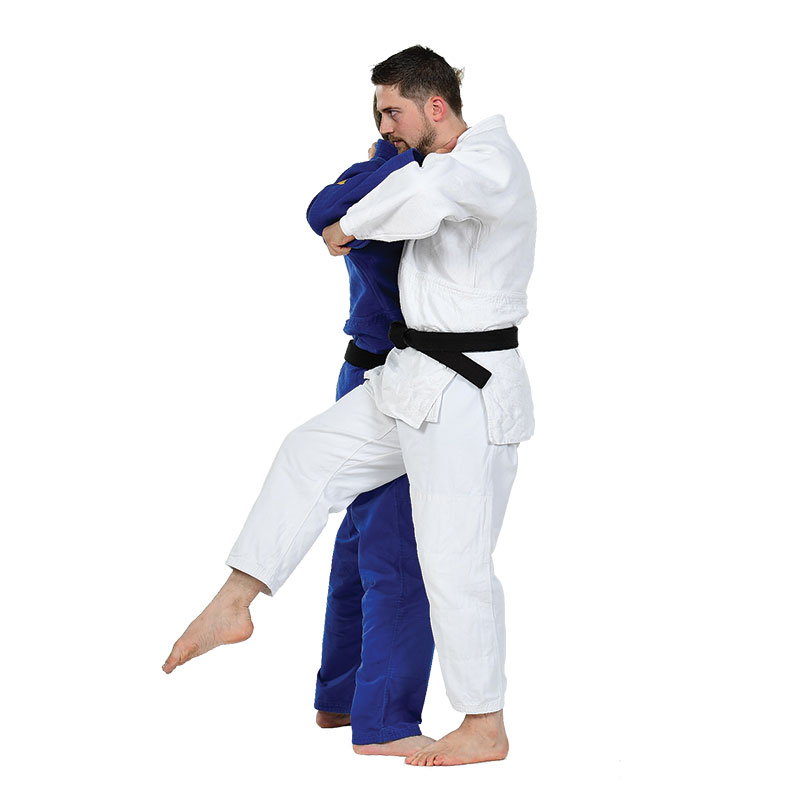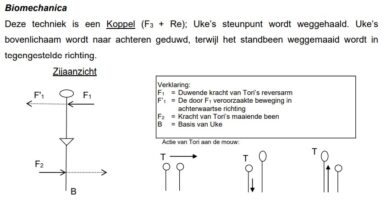O-soto-gari 大外刈 (“Major Outer Reap”)
Category: Ashi-waza (Foot Techniques)
Translation: “O” = major, “soto” = outer, “gari” = reap — Major Outer Reaping Throw
Description
O-soto-gari is one of the most fundamental and widely used judo throws. It involves breaking your opponent’s balance backward (to their rear-right corner) and then reaping their supporting leg out from under them, using a strong, sweeping motion.
To execute the technique:
-
Tori pushes uke’s upper body backward to shift their weight onto the right foot and heel.
-
Tori then sweeps uke’s right leg (the support leg) from the outside using their own right leg in a large, arcing motion, causing uke to fall directly backward.
It is a high-impact throw, particularly effective in both shiai (competition) and demonstration contexts due to its power and visibility.

Biomechanics of O-soto-gari
-
Throw type: Couple (Re + F3)
-
Support point: Uke’s right leg
-
Kuzushi (Balance Breaking): Backward, into uke’s rear-right corner
-
Action:
-
Tori pushes uke’s upper body backward (Re)
-
Simultaneously, tori sweeps uke’s supporting leg in the opposite direction (F3)
-
-
This counter-rotational force forms a couple, removing uke’s support base and ensuring a clean fall.
-
Tori’s sweeping leg must move in a straight arc, timed precisely as uke’s weight shifts to the rear leg.

Did you know?
-
O-soto-gari is one of the oldest and most iconic judo throws, included in the first group of the Gokyo no Waza and featured in the Nage-no-Kata.
-
Despite its fundamental status, O-soto-gari is considered one of the most dangerous throws in judo. The backward fall can result in injuries if uke lacks sufficient ukemi (falling) skills or if the throw is executed too aggressively.
-
Many judo instructors teach O-soto-gari early in a judoka’s journey — particularly in the Kawaishi system, where it is the first throw introduced. However, due to its intensity, this has led to many reported injuries, especially among beginners.
-
High-level judoka like Toshihiko Koga and Shohei Ono have used variations of O-soto-gari in world championship finals, making it both foundational and elite.
Methodical Progression
Below are structured practice methods to help judoka isolate and master components of the technique.
Renraku-waza 連絡技 – Combinations in Opposite Directions
Renraku-waza, or “linking techniques”, involve combining throws in opposite directions. If the first attack is resisted or partially defended, tori redirects the movement and executes a second throw in the opposite direction. This approach is highly effective for breaking uke’s defence and regaining initiative.
Renzoku-waza 連続技 – Combinations in the Same Direction
Renzoku-waza refers to consecutive techniques that follow the same direction of movement, progressively unbalancing uke until a throw is achieved. While less discussed explicitly, this principle is widely used in randori and shiai to maintain pressure and rhythm.
Combinations Starting with O-soto-gari
Part 1
Combinations Starting with O-soto-gari
Part 2
Combinations Ending with O-soto-gari
Part 1
Combinations Ending with O-soto-gari
Part 2
Kaeshi-waza 返し技 – Counter Techniques
Kaeshi-waza refers to counter-throws where tori reverses uke’s attack using timing and redirection. The key elements include:
- Exploiting Unbalance: Uke becomes temporarily unstable during their attack. Tori uses this moment to counter.
- Redirecting Force: Rather than resisting, tori guides uke’s force into a vulnerable angle.
- Blending with Movement: By moving with uke’s attack, tori stays in control and prepares a reversal.
These counters are fundamental to tactical judo and emphasize using uke’s momentum against them.